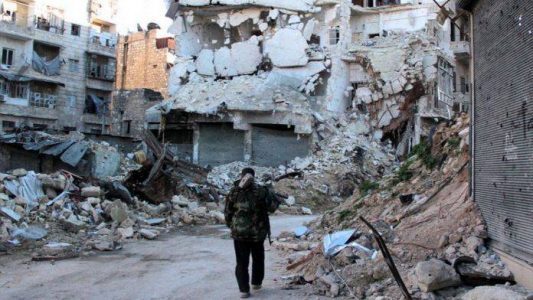
Terrorist groups in balkanised Syria have found the perfect place to train for global terror attacks
As conflict enters its ninth year in Syria, let us take look at how a failed Arab Spring, geopolitics and competing jihad have made Syria a base for global violence. And even though the Islamic State of Iraq and al-Sham –ISIS – control over the country has shrunk, Syria hasn’t seen the end of terrorism yet.
The Syrian Spring, which started in March 2011, led to the balkanisation of Syria – making it a jihadi cauldron. It is now a theatre for radicalisation and actual training of fighters – under anyone from al-Qaeda (AQ) to ISIS networks – who can carry out attacks anywhere in the world, without it being traced back to Syria.
Apart from the Bashar al-Assad regime, other states, extremists and violent jihadis exercise control over different parts of Syria and are fighting for greater influence. While the current military campaign of the Assad regime in the northern province of Idlib and the threat of imminent military campaign of Turkey in north-eastern parts of Syria under the control of US led-Syrian Democratic Force add to the complexities, both the Islamic State and al-Qaeda continue to rebuild their infrastructure and fighting strengths on the ground.
The US withdrew its troops from Iraq in December 2011, claiming success in decimating the al-Qaeda in Iraq (AQI) and having killed Osama Bin Laden in Pakistan a few months earlier. It was claimed that a severely weakened AQI of about 700 cadres, under the leadership of Abu Bakr Baghdadi (current emir of ISIS), was no match for the Iraqi government, which was then led by pro-west PM Nouri al-Maliki.
However, before December 2011, AQI’s Syrian branch, Al Nusrah Front (ANF), led by Abu Muhammad al-Julani had already dispatched hundreds of cadres to Syria to grab territory and sources of funding, including oil fields. The ANF soon initiated suicide attacks and aligned with other armed groups against Assad, including with al-Qaeda affiliate, Ahrar-al-Sham. These groups, also loosely referred to as the Free Syrian Army (FSA), were actively supported by regional players to further their geopolitical interests in Syria.
In April 2013, the AQI morphed into ISIS – Islamic State of Iraq and al-Sham. The ISIS declared that it had subsumed the Al Nusrah Front, gaining significant domination across 10 of the 14 governorates of Syria within a few months. On 29 June 2014, the ISIS declared the Caliphate, stretching across large swathes of Syria and Iraq.
However, under al-Qaeda emir Ayman Al Zawahiri, ANF proclaimed itself independent of the ISIS in Syria. Many top al-Qaeda leaders, including those of the Khorasan group, shifted to Syria, but Zawahiri and his core team continued to operate from the Afghanistan-Pakistan region, drawing on tactical advantage of terrain and patronage. Eventually, the Free Syrian Army disintegrated and its sub-groups/fighters joined ISIS or al-Qaeda networks.
The US withdrew its troops from Iraq in December 2011, claiming success in decimating the al-Qaeda in Iraq (AQI) and having killed Osama Bin Laden in Pakistan a few months earlier. It was claimed that a severely weakened AQI of about 700 cadres, under the leadership of Abu Bakr Baghdadi (current emir of ISIS), was no match for the Iraqi government, which was then led by pro-west PM Nouri al-Maliki.
However, before December 2011, AQI’s Syrian branch, Al Nusrah Front (ANF), led by Abu Muhammad al-Julani had already dispatched hundreds of cadres to Syria to grab territory and sources of funding, including oil fields. The ANF soon initiated suicide attacks and aligned with other armed groups against Assad, including with al-Qaeda affiliate, Ahrar-al-Sham. These groups, also loosely referred to as the Free Syrian Army (FSA), were actively supported by regional players to further their geopolitical interests in Syria.
In April 2013, the AQI morphed into ISIS – Islamic State of Iraq and al-Sham. The ISIS declared that it had subsumed the Al Nusrah Front, gaining significant domination across 10 of the 14 governorates of Syria within a few months. On 29 June 2014, the ISIS declared the Caliphate, stretching across large swathes of Syria and Iraq.
However, under al-Qaeda emir Ayman Al Zawahiri, ANF proclaimed itself independent of the ISIS in Syria. Many top al-Qaeda leaders, including those of the Khorasan group, shifted to Syria, but Zawahiri and his core team continued to operate from the Afghanistan-Pakistan region, drawing on tactical advantage of terrain and patronage. Eventually, the Free Syrian Army disintegrated and its sub-groups/fighters joined ISIS or al-Qaeda networks.
Although the Caliphate lost territory, the fight against the Caliphate also created an opportunity for the Zawahiri led-AQ network in Syria to not only survive, but also grab territory. Currently, much of the province of Idlib, parts of Hama and Latakia, are under the control of the Hayat Tahrir al-Sham or HTS network – that has been designated as an al-Qaeda affiliate by the US and the United Nations.
The HTS is running a government for areas under its control, even though they don’t call it a Caliphate or Islamic State. For tactical reasons, the HTS, in its propaganda, is proclaiming a break up with al-Qaeda fighters, especially the foreign ones. In early 2018, the foreign fighters with the AQ/HTS created another group – the Huras al-Din (HD). This group is now carrying out regular propaganda as an al-Qaeda branch through videos and even naming camps after slain AQ leaders, including ‘legendary’ Sheikh Abu Firas al-Suri. The HTS and its backers are positioning the group as a legitimate local group and claiming to have no connection with any transnational jihadi groups, much like the Afghan Taliban are trying to do.
Source: The Print





